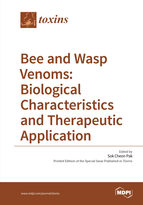Bee and Wasp Venoms: Biological Characteristics and Therapeutic Application
A special issue of Toxins (ISSN 2072-6651). This special issue belongs to the section "Animal Venoms".
Deadline for manuscript submissions: closed (1 August 2015) | Viewed by 140618
Special Issue Editor
Interests: evidence-based practice; bee venom; nutrition; reproduction; cancer; natural medicine
Special Issues, Collections and Topics in MDPI journals
Special Issue Information
Dear Colleagues,
Bee or wasp venom therapy is the therapeutic application of honeybee venom or wasp venom to the treatment of various diseases. Venoms from either honeybees or wasps are known to possess a wide variety of pharmaceutical properties. Recent studies using these venoms have demonstrated diverse mechanisms on a range of conditions. However identification of a single constituent out of the venom, the possible mechanisms, and a justification of the route of application and formulation are essential in the future. Understanding of signalling pathways associated with the compound-mediated in vivo dynamics and further communication between cells at the molecular level will facilitate the development of new therapeutics.
Dr. Sokcheon Pak
Guest Editor
Manuscript Submission Information
Manuscripts should be submitted online at www.mdpi.com by registering and logging in to this website. Once you are registered, click here to go to the submission form. Manuscripts can be submitted until the deadline. All submissions that pass pre-check are peer-reviewed. Accepted papers will be published continuously in the journal (as soon as accepted) and will be listed together on the special issue website. Research articles, review articles as well as short communications are invited. For planned papers, a title and short abstract (about 100 words) can be sent to the Editorial Office for announcement on this website.
Submitted manuscripts should not have been published previously, nor be under consideration for publication elsewhere (except conference proceedings papers). All manuscripts are thoroughly refereed through a double-blind peer-review process. A guide for authors and other relevant information for submission of manuscripts is available on the Instructions for Authors page. Toxins is an international peer-reviewed open access monthly journal published by MDPI.
Please visit the Instructions for Authors page before submitting a manuscript. The Article Processing Charge (APC) for publication in this open access journal is 2700 CHF (Swiss Francs). Submitted papers should be well formatted and use good English. Authors may use MDPI's English editing service prior to publication or during author revisions.
Keywords
- honeybee venom
- wasp venom
- pharmaceutical
- signaling pathway
- therapeutics







